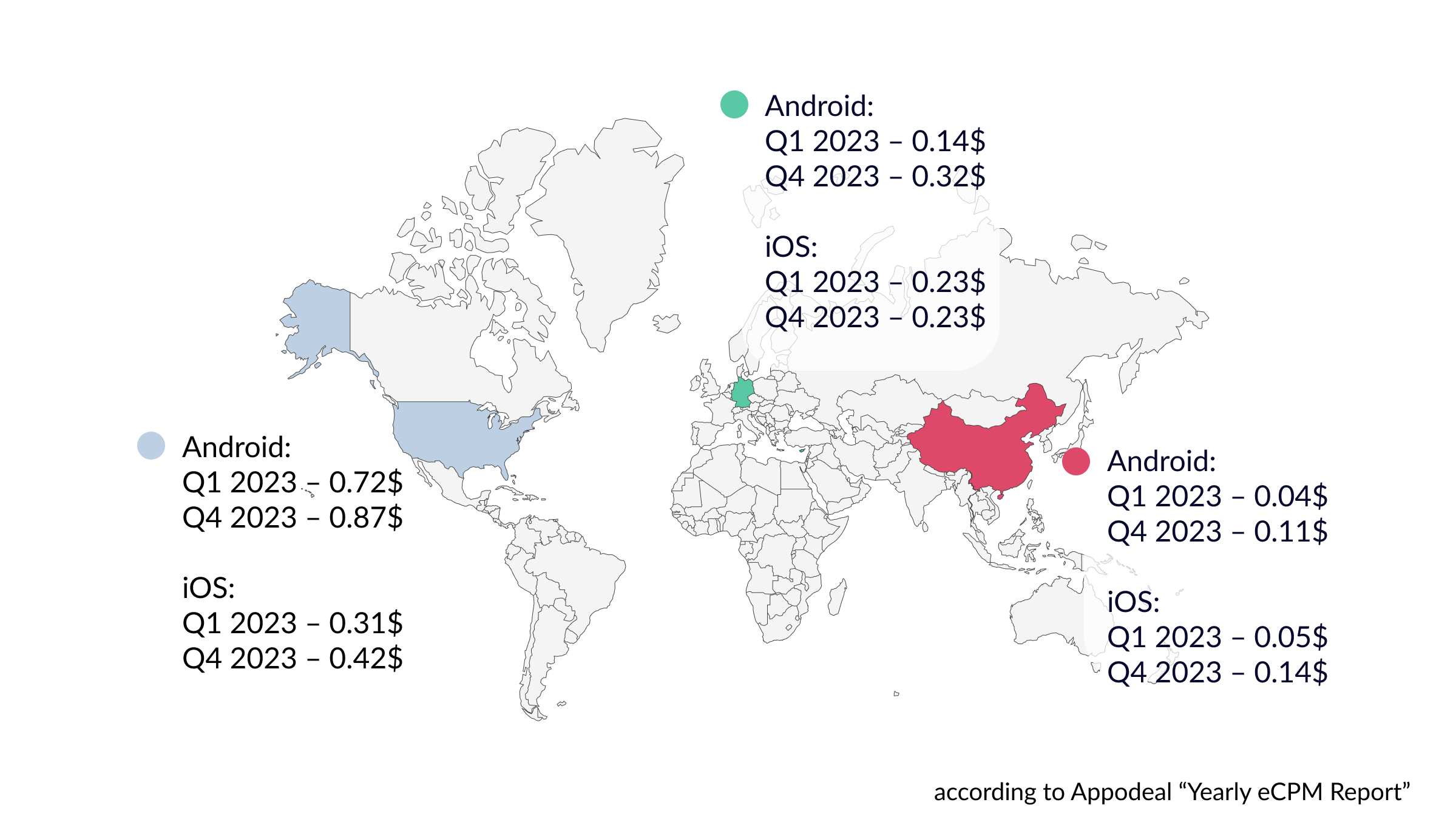
Banner ads, despite being the oldest form of digital advertising, continue to be widely favored, particularly on mobile devices. This trend is understandable as people increasingly rely on mobile phones and use larger devices like desktop computers, laptops, and tablets less often. The era when banners were restricted to static images is over. For quite a few years now, in addition to images with text, there can be animated or video banners, making them more dynamic and effective than ever. If you’re curious about the fascinating history of mobile banner ads and you question their relevance in the current digital advertising landscape, this article is a must-read!
What is mobile banner advertising?
Suitable for publishers of any size, banner ads are a standard advertising format on websites, streaming platforms, and also mobile apps. Mobile banners, in particular, are displayed on websites or applications accessed through mobile phones. The publisher can implement this ad type using all three of the most essential Google monetization solutions: AdSense, AdMob, and Google Ad Manager. The most essential mobile banner ads properties include:
- rectangular shapes;
- they are typically displayed at the top or bottom of the mobile screen and don’t cover the entire screen as Interstitial ads do;
- they occupy rectangular parts of the screen of a mobile device that can be scrolled or pinned and remain visible while the users scroll;
- in contrast to native ads, this ad type, especially large banner ads, offers high visibility and doesn’t blend in that much with app or website content;
- due to the variety of available ad sizes, it can be implemented even in a limited space;
- mobile banners can display various ad types, including rich media, static, and video ads, enabling effective website or app monetization;
- banner ads are often displayed for the duration of the user session, yet they can be set to refresh automatically;
- they are among the types of mobile ads that are the easiest to implement.
A brief history of banner ads
The date of a banner ad’s first appearance on the World Wide Web is disputable. Some sources state that the web’s inaugural clickable banner ad was introduced already in 1993. Others declare that this ad type was first displayed (on hotwired.com, the online version of Wired magazine) in 1994. Interestingly, 44% of users clicked that advertisement – a number unimaginable today. Regardless of the date, it’s certain that banner ads have been around since the dawn of digital advertising.
Rectangular banners became available on mobile websites in the early 2000s. Back then, mobile sites were simple and included a lot of text, restricting how ad content and mobile banner design looked like. After the launch of the iPhone in 2007, the situation changed, and mobile ads became more visually appealing. One year later, Apple’s App Store was launched, and Google Play shortly after. Due to that, the mobile landscape experienced a significant shift towards apps, creating a demand for app publishers to find effective ways to monetize their creations. Mobile banner ads have become a standard practice for app monetization.
From the early 2010s, mobile ad networks like AdMob facilitated the placement of mobile app ads, and in 2013, programmatic advertising started to influence mobile advertising. From approximately 2016, the increase in installations of ad blockers created obstacles for mobile banner campaigns designers and publishers. However, this resulted in finding new ways to make ads less disruptive.
Surprisingly, many leading tech experts predicted the fast end of banner ads. For instance, in 2016, Tejal Patel (then director of consumer engagement at Microsoft) said this ad type would no longer exist in the mobile advertising environment in three years. Fortunately, more than eight years later, mobile banner ads are increasingly popular.
Nowadays, banner ads have evolved to include interactive and rich media elements, such as animations, videos, and interactive features, making them more captivating. Moreover, improvements in mobile technology, like 5G, have facilitated faster loading times and smoother ad experiences.
Pros and cons of mobile banner ads
Pros:
- Banner ads are well-known to potential customers. They have existed since the very beginning of the World Wide Web and are still one of the most popular ad formats;
- This ad type is easy to implement. Various networks and platforms provide a range of tools, plugins, and resources that streamline the process, making it achievable even for publishers with minimal technical knowledge. This simplicity in implementation enables publishers to promptly begin earning revenue from their mobile traffic;
- After a set duration, banner ad units can be programmed to refresh automatically without the need to refresh the page or screen. This is a good monetization practice that can help boost ad revenue. Ad refresh can be triggered by three main factors: user actions (such as reaching the end of an article), predefined events set by the publisher, and a set time interval (usually 30, 60, or 90 seconds). AdSense does not permit ad refresh, but you can set it in Google Ad Manager (available only for mobile app inventory) and AdMob. Google experts suggest that the ad’s optimal time for display is 60 seconds. This solution is particularly effective for apps and websites where the average session duration is high, for instance, within pages with endless scroll or gaming apps;
- Increased revenue due to broad reach and targeting options. Mobile banner ads can reach users from various demographics and geographic locations. The advanced targeting features offered by ad networks allow publishers to display advertisements that are in line with the audience’s interests and behavior;
- Mobile banner advertising helps to enrich ad diversity, which is particularly important for the safety of ad revenue. If one ad type is underperforming, the other can compensate for it. The practice of diversifying revenue streams in display advertising should be a basis for every well-thought-out ad monetization strategy;
- They come in a variety of ad sizes and types, including animated banners, rich media ads and ads with video content;
- You can easily track the performance of banner ads. Metrics like impressions, Click-Through Rates (CTR), and conversion rates provide valuable insights into the success of ad placements and the overall monetization strategy. This data-driven approach should assist publishers in checking whether their ad strategy is on track.
Cons:
- When monetizing with banners, revenue fluctuations can arise from market trends and seasonality issues (common across all ad formats). For example, the end of the year is typically more profitable for most publishers as advertisers aim to reach the target audience searching for Christmas gifts or New Year’s Eve attire;
- Another possible threat is banner blindness. Because banner ads are the oldest digital advertisement type, most people associate them with stereotypical digital ads, which makes them more likely to be ignored. However, there are several proven methods to avoid this effect that can hurt the value of your ad inventory. The two most important ones concerning mobile banner ads are avoiding too high ad density and focusing on finding the best ad placement – but we will explain these concepts further in the following paragraphs;
- Ad blockers are another possible challenge publishers must consider when choosing banner ads. Ad blockers can stop the display of ads on mobile websites, which can decrease potential revenue. Most ad blockers are configured to permit ads that comply with the Acceptable Ads Standard by default (meaning ads that are non-intrusive to users). Sadly, some users may opt to disable all forms of advertising except for those they manually add to a whitelist.
Mobile banner ad sizes
The final size of a mobile banner ad depends on many factors. For instance, in the case of Google products, after choosing a specific ad size and implementing it in your ad layout, smaller banners can also appear within this ad unit. An example of this practice might be a mobile banner ad implemented on a website in the AdSense environment that is 320 x 100, but it allows the display of ads that are 320 x 50. It is also vital to remember about regional ad sizes, which are the ones that perform best in certain parts of the world. For instance, a popular ad size in China might not perform as well in Europe.
What is the best size for mobile banner ad?
Below, you will find a list of the most popular mobile banner ad sizes displayed worldwide:
320 x 50 Mobile Leaderboard
320 x 50 is a mobile banner ad size, one of the most popular choices for Google AdSense publishers. It’s relatively small and doesn’t take up too much advertising space as it’s only 50 px in height and 320 px in width. AdSense recommends placing this ad size above the fold. Other names for a Mobile Leaderboard include standard banner and Smartphone Leaderboard. Interestingly, the term “leaderboard” comes from sports vocabulary – it’s a display showing player results during a match.
300 x 250 Medium Rectangle
300 x 250 is an ad size that can convey more information than the previous one mentioned. They are sometimes called MPUs (Mid-Page Units) or MRECs (from the name Medium Rectangle ads). A Medium Rectangular Banner most often appears when users scroll an app or mobile page content.
336 x 280 Large Rectangle
336 x 280 is a banner ad that is one of the most popular mobile ad sizes due to its effectiveness. It performs best with animated and video banners, but it’s not allowed for AdMob users.
Other popular ad formats supported by Google Ad Manager include 300 x 50 and 300 x 100. Google AdMob allows the usage of the following banner ad sizes if the Adaptive Banners (you can read more about them below) aren’t implemented: 320 x 50, 320 x 100, and 300 x 250.
Smart Banners
Smart Banners are deprecated mobile app advertising units in Google AdMob and Google Ad Manager. They fall into the responsive mobile ads category, designed to adjust to different devices and screen sizes. They check the width of the device the user is currently utilizing and adjust the ad’s size to the detected one. Despite their popularity for a certain period, Smart Banners are no longer recommended to publishers. Instead, Google suggests going for Adaptive Banners.
Adaptive Banners
Adaptive Banners are responsive mobile ad units that can be implemented for websites and apps that utilize Google Ad Manager and AdMob. They are a step ahead of Smart Banners, as they offer a better User Experience and reduce the likelihood of ads appearing too small. There are two kinds of Adaptive Banners:
- Anchored ads that stay on-screen, positioned at the top or bottom,
- Inline ads are designed to fit within scrollable content and can be larger since users typically scroll past them.
How much do mobile banner ads pay?
The eCPMs (Effective Cost Per Mille) for mobile banner ads within apps or placed on websites may vary due to multiple factors. Firstly, eCPM rates are impacted by the geographical location of the app’s or website user base, as the ad spend might be higher in affluent regions. Additionally, the app or a page niche or industry can influence ad rates, with sectors such as finance or gaming commanding higher prices.
Moreover, eCPMs may fluctuate due to the above-mentioned seasonal changes and shifts in market demand, which are driven by advertiser budgets and targeting strategies. When speaking about apps, other factors include differences in earnings depending on the platform, whether you choose iOS or Android. The efficient way to roughly check how much you can make on mobile ad banners is through statistics and reports.
According to Appodeal “Yearly eCPM Report” the average eCPM rate for banner ads on Android in China in the first quarter of 2023 was 0.04$, 0.14$ in Germany, and 0.72$ in the USA, on iOS the eCPMs equaled respectively: 0.05$, 0.23$ and 0.31$.
On the contrary, the average eCPM rate for banner ads on Android in China in the last quarter of 2023 was 0.11$, in Germany, it was 0.32$, and in the USA, 0.87$. In the same time frame, but on iOS, the average eCPM rate in China was 0.14$, 0.23$ in Germany, and 0.42$ in the USA.

This data clearly shows that average banner ad earnings depend not only on the geographical location and time of the year but also on the chosen platform, so it’s difficult to predict the profits you will generate from your app based only on partial data.
Tips for using mobile banner ads
If you are wondering what are the best practices for mobile banner advertising here are some easy aspects to keep in mind:
- Choose the best ad placement for banner on your website or app, and remember that a suspiciously high number of accidental clicks may cause trouble. Here are some of the best pieces of advice:
- according to Google AdMob, app developers shouldn’t locate this ad type in close proximity or between interactive app elements. Instead, developers can, among others, implement non-clickable padding/space that separates playable, interactive elements from ads,
- additionally, banners can’t cover any app parts that users can view or slide into interactive content. Users shouldn’t have a problem with differentiating an advertisement from app content,
- plan in advance and find a fixed place for an ad in an app. This way, a layout shift can be avoided,
- when it comes to AdSense policies for mobile web banners’ placement, large ads like 300 x 250 can’t be located above the fold;
- Avoid placing too many ads on your website or within your app. Too high ad density can hurt the User Experience. The Better Ads Experience Program, a project of the Coalition for Better Ads, indicates that an ad density higher than 30% can harm publishers and users. Ultimately, it’s the mobile app or website content that interests users the most. If your audience doesn’t find the information or experience they were looking for in the first place, they will decide to leave, and monetization effects won’t be as effective as they could. Another reason for going for more moderate ad numbers is the fact that nowadays, there are plenty of websites and apps, so if the user doesn’t like how you set up your digital space, they will probably look for an alternative quickly;
- A way to detect any anomalies and issues is through continuous monitoring and analysis of ad performance. You should regularly review metrics and make necessary adjustments based on data insights to improve ad effectiveness and revenue generation.
Your success is our success!
Mobile banner ads bring many benefits for digital publishers. They help generate revenue, are easy to set up, reach a large audience, and their performance can be easily tracked. However, there are also some challenges. If placed incorrectly, these ads can disrupt the User Experience, people might ignore them, and ad blockers might stop them from being displayed. To mitigate problems, partner with professional monetization services, such as GCPP badge holders like optAd360. This will ensure adequate ads reach the intended audience, the most optimal ad placement, and constant ad revenue progress. We will implement banner ad units in the most suitable and profitable places, offer other mobile display ads formats, and increase your ad revenue. With solutions like Revenue Booster, which continuously perfects your ad layout by incorporating new ad formats with higher user activity, or Ad Mapper, which creates profitable ad layouts from scratch, you will succeed in no time! Just read our requirements and fill out the registration form!

